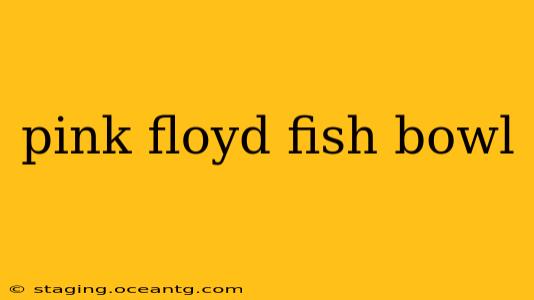Pink Floyd's music is renowned for its evocative imagery and cryptic symbolism, and few images are as striking and enduring as the "fish bowl" motif that appears throughout their work. While not explicitly a single, defined concept, the recurring image of a fish bowl (or, more broadly, aquatic imagery) acts as a potent metaphor across different songs and albums, reflecting themes of confinement, observation, alienation, and the search for freedom. This exploration delves into the various interpretations and contexts of the "fish bowl" in Pink Floyd's creative output.
What is the significance of the fish bowl in Pink Floyd's music?
The significance of the fish bowl isn't explicitly stated by the band, leaving room for diverse interpretations. However, the recurring imagery strongly suggests a feeling of being trapped, observed, and ultimately, detached from the outside world. The fish, confined within its transparent prison, becomes a powerful symbol of the human condition – vulnerable, yet simultaneously on display. The bowl itself represents the limitations and constraints of society, technology, or even the self.
Does Pink Floyd have a song called "Fish Bowl"?
No, Pink Floyd doesn't have a song explicitly titled "Fish Bowl." The image is a recurring motif woven into various songs and album artwork, notably in the context of "Shine On You Crazy Diamond," "Careful with That Axe, Eugene," and the artwork for Animals. The fish bowl isn't a literal subject, but rather a potent symbol used to convey deeper meaning within the broader narrative of each piece.
What other aquatic imagery is used by Pink Floyd?
Beyond the fish bowl, Pink Floyd frequently employs other aquatic imagery, further reinforcing the themes of confinement and observation. Images of water, swimming, and submerged environments appear across their work, often suggesting a liminal space between reality and the subconscious. This underscores the sense of being lost, adrift, or struggling to break free from societal or internal constraints. The use of water also speaks to the subconscious, a place where hidden thoughts and anxieties reside.
How does the fish bowl imagery relate to the overall themes of Pink Floyd's music?
The fish bowl imagery perfectly encapsulates many recurring themes in Pink Floyd's music:
- Alienation and Isolation: The fish, alone in its bowl, mirrors the feeling of being separated from the world and misunderstood.
- Surveillance and Observation: The transparent nature of the bowl suggests a constant state of being watched and judged.
- The Search for Freedom: The fish's struggle to navigate its confined space reflects the human desire for liberation from limitations.
- The Power of Illusion: The seemingly simple image of a fish bowl can represent the deceptive nature of appearances and the fragility of reality.
Where else does the fish bowl imagery appear in Pink Floyd's work?
While not explicitly named, the imagery and its associated themes resonate throughout Pink Floyd's catalog, both musically and visually:
- Album Art: The visual elements of their album art frequently incorporate aquatic or related imagery, subtly reinforcing the themes explored in the music.
- Live Performances: Stage designs and projections during live performances sometimes include aquatic elements, further emphasizing the recurring motifs.
- Lyrical Content: Metaphorical references to confinement and observation, which are deeply connected to the fish bowl symbolism, are woven into the lyrics of various songs.
In conclusion, while Pink Floyd doesn't explicitly feature a song or album titled "Fish Bowl," the recurring motif is a significant element in their artistic expression. It acts as a potent and versatile symbol, allowing for rich interpretations and adding depth to the band's exploration of alienation, confinement, and the enduring search for freedom. The ambiguity surrounding the imagery adds to its power, allowing each listener to connect with its symbolic meaning on a personal level.
